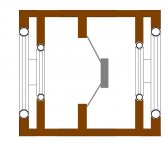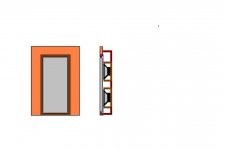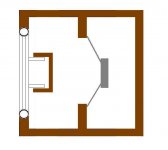Make an equivalent schematic for the same values, and you'll find that it comes out as exactly the same thing.
The same values of what? The lever input and output areas? Then of course it does, but that would be a dumb way to make a lever. But if the input and output areas are different then the two schematics aren't the same. There is a transformer of area ratios, which is where the whole advantage comes from.
You don't think that I've done this? Thats incredibly nieve.
I don't waste my time on things that don't work and I never would have spent the money to get a patent if it didn't work. It works and it works well.
I didn't start this thread and I wouldn't have because I cannot explain the answers in detail and so there isn't any point in talking about it, but its ridiculous to think that I haven't actually proven all that I have said.
The efficiency increase you describe does not come from the use an acoustic lever. The acoustic lever is simply a PR system, and could easily be replaced by a single PR driver with the combined parameters of the acoustic lever system (if you can find one that would have those). The efficiency increase comes from the BP box design. The narrower frequency output you design a BP to have the higher the efficiency. In extreme cases you could get up to +6dB increase.
Don't despair though, theoretically it's a brilliant design (the BP/PR combo), alas in real life it's much harder to get to work correctly and reliably over time.
Don't despair though, theoretically it's a brilliant design (the BP/PR combo), alas in real life it's much harder to get to work correctly and reliably over time.
This IS the single biggest limitation, that is correct - at least on paper. But in practice we found ways arround this resulting in more actual output for a fixed volume of enclosure. That aspect is a trade secret however that I have to reserve for a time when I might make a lever sub.
Sounds like hype to me. I hate it when someone "trade secretes" me. 🙂 If you want to make the volume smaller while keeping the compliance constant then the box can be filled with SF6. Box compliance goes like 1/k, k = ratio of specific heats. Air has k= 1.4, SF6 = 1.0 or there abouts. So using SF6 to fill the enclosure make the box look 40% bigger. Or you can reduce the box volume by 30%.
I didn't start this thread and I wouldn't have
That ofcourse makes a difference
Last edited:
Could this idea be used to increase the bass output of an open baffle. The larger outer cone being in the open baffle and its rear radiation partly relieved by the movement of the inner cone. Maybe that cone could be left out and just have a driver in a box coupled to the open baffle. I have no idea whether there would be sufficient difference in outputs for this to work, just thinking aloud!
jamikl
jamikl
Actually this concept is discused in my book. It does offer some improvement in effciency along with a more cardiod polar patern, but in the book the lever is on the back not on the front. The front is a good idea though.Could this idea be used to increase the bass output of an open baffle. The larger outer cone being in the open baffle and its rear radiation partly relieved by the movement of the inner cone. Maybe that cone could be left out and just have a driver in a box coupled to the open baffle. I have no idea whether there would be sufficient difference in outputs for this to work, just thinking aloud!
jamikl
Now stop - feels sooooo good 🙂
I did

Is this the same idea?:
http://www.qualifi.com.au/index.jsp...ion=brands&page=product_detail&product=104153
http://www.qualifi.com.au/index.jsp...ion=brands&page=product_detail&product=104153
Could this idea be used to increase the bass output of an open baffle.
jamikl
Why not 🙂
Just remember that OB and dipole may not be the same thing
But sure, dipole sub ought to be a good match to OB
Attachments
I don't think it is the same PeteMck. The article says it trades excursion for
surface area. My understanding is that the system discussed here uses a long throw smaller driver so the the larger driver not only has increased surface area but the full excursion of the smaller driver. May be wrong there though.
jamikl
surface area. My understanding is that the system discussed here uses a long throw smaller driver so the the larger driver not only has increased surface area but the full excursion of the smaller driver. May be wrong there though.
jamikl
I don't think it is the same PeteMck. The article says it trades excursion for
surface area. My understanding is that the system discussed here uses a long throw smaller driver so the the larger driver not only has increased surface area but the full excursion of the smaller driver. May be wrong there though.
jamikl
Agree
The efficiency increase you describe does not come from the use an acoustic lever. The acoustic lever is simply a PR system, and could easily be replaced by a single PR driver with the combined parameters of the acoustic lever system (if you can find one that would have those). The efficiency increase comes from the BP box design. The narrower frequency output you design a BP to have the higher the efficiency. In extreme cases you could get up to +6dB increase.
Don't despair though, theoretically it's a brilliant design (the BP/PR combo), alas in real life it's much harder to get to work correctly and reliably over time.
I'm not sure I see any difference either. The outer surface will still be required to compress and rarefy the volume behind it, the smaller surface will only reduce this requirement by its own displacement.
I'm not sure I see any difference either. The outer surface will still be required to compress and rarefy the volume behind it, the smaller surface will only reduce this requirement by its own displacement.
There definately is a difference and I have tried to be clear on what it is. The simplest way to see this is to go back to the very first post and simplify this circuit as follows. Assume for now that the volume between the two lever surfaces can be made arbitrarily large and that the compliance of the lever itself can be made arbitrarily high. This will elliminate the caps Cm1, Cm2 and Cav. Now move the lever mass into the acoustic part between the Sd transformer and the S1 transformer. The circuit is then precisely a bandpass system with one exception. There is now a transformer of turns ratio S2:S1 on the acoustical side.
Loudspeakers are very inefficient because the "load" seen by them is so much smaller than their impedance level that they have trouble delivery "work". In other words the air is way too soft to allow for any real work to be done on it. The transformer on the output raises the low impedance of the air up to create a greater load on the driver and hence a greater efficiency. This is in addtion to the greater load presented as a result of the front box resonance - the normal "bandpass effect" that raises the efficiency of a bandpass enclosure.
As John points out it is the volume between the levers that is the Achiles Heel of the whole design and if you can't find some way arround its need to be fairly large to be effective then in the end the system just gets too big to be practical. The compliance of the lever turns out not to be a big problem. So theoretically I can get any level of efficiency gain that I want, but practically it is limited by two things - the durability of the lever when it is made light enough, and the volume between the two lever surfaces. Both of these problem can be solved, but the solutions aren't so obvious.
In our studies a practical limit of about 6 dB (over a normal bandpass system) was found to be workable, but going beyond that, things got problematic fast. In other words a 2:1 ratio of output area to input area was the limit of what we were able to make work.
And what I'm saying is that exact effect can be achieved with a single PR with the same parameters as the acoustic lever.
It just requires an active driver to be used as a PR, bandpass limit that. And you have exactly the same effect. That will also enable it to go beyond the normal limit of a BP box in effeciency in a very narrow frequency band just like the acoustic lever.
It just requires an active driver to be used as a PR, bandpass limit that. And you have exactly the same effect. That will also enable it to go beyond the normal limit of a BP box in effeciency in a very narrow frequency band just like the acoustic lever.
There might be another way, into the pure passive radiator
I wasnt sure I would show it, because its patent pending
Its a stolen child, yes
A stolen phrase from Irish history and the huge and sexy miss Mckinney
1. Either use a big power driver to improve its lack of low end sensitivity
2. Or use a long throw low sensitive sub driver to improve its general sensitivity
Either way, its about transforming energy into excursion
Fore a BR its like a peaked design
Only, this time its sort of mechanical hydraulic device
Cheating ?
Does cheating really work at all
Is it possible to deal with all the drawbacks
Does Hofmans law say no?
But converting any energy into long excursion tells me maybe best not consider it fore high SPL
But its tempting to at least try it
I wasnt sure I would show it, because its patent pending

Its a stolen child, yes
A stolen phrase from Irish history and the huge and sexy miss Mckinney
1. Either use a big power driver to improve its lack of low end sensitivity
2. Or use a long throw low sensitive sub driver to improve its general sensitivity
Either way, its about transforming energy into excursion
Fore a BR its like a peaked design
Only, this time its sort of mechanical hydraulic device
Cheating ?
Does cheating really work at all
Is it possible to deal with all the drawbacks
Does Hofmans law say no?
But converting any energy into long excursion tells me maybe best not consider it fore high SPL
But its tempting to at least try it
Attachments
Last edited:
That is correct. Bose have done extensive research into coupled cavity designs. But effectively it doesn't matter whether you use passive resonants (ports), passive radiators or actively filtered passive drivers to achieve the effect.
Assume for now that the volume between the two lever surfaces can be made arbitrarily large
Example dipole sub (Drawing 1 of post #50 this thread)
as shown with equal opposing levers front and back:
Seems you might could short circuit front lever trapped
difference volume to the back lever, and maybe make
both compliance volumes appear to behave as infinate??
I'm not saying dipole is actually a workable concept
for a subwoofer. Surely a few will still insist to try...
Last edited:
But effectively it doesn't matter
There is a trick you still deny to understand
Whether it works 100% or 50%, or not at all, is another matter
A hard working driver may throw the smaller inner side of the PR to kingdom come
How do you think that works if the outer side is twice as big
Right now, weight could be a problem
Why I would be cautious with SPL
Attachments
Last edited:
It just requires an active driver to be used as a PR,
 Oh Yea, thats exactly the same thing 🙄
Oh Yea, thats exactly the same thing 🙄- Status
- Not open for further replies.
- Home
- Loudspeakers
- Multi-Way
- Geddes on Acoustic Lever




